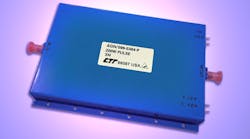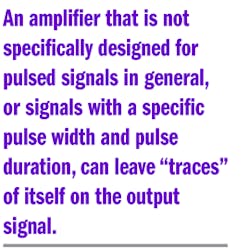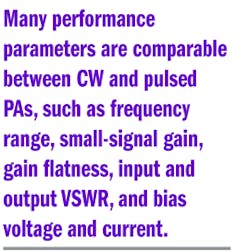Choosing Between CW and Pulsed Power Amps
This file type includes high-resolution graphics and schematics when applicable.
Power amplifiers (PAs) for RF/microwave use come in various shapes and sizes, at many different performance levels, and based on numerous technologies. Differences in capabilities separate one PA from another as a better fit for a particular system. But one key difference perhaps stands apart from the rest: Has the PA been designed for continuous-wave (CW) or pulsed amplification, such as in communications or radar systems, respectively. Furthermore, what characteristics can help make an amplifier a good fit for either a CW or pulsed application?
Whether based on vacuum tubes or solid-state semiconductor devices, PAs must be designed for either CW or pulsed operation—not for both modes. One reason is that the active devices within an amplifier are typically biased in such a way as to satisfy a blend of performance tradeoffs, including gain, linearity, efficiency, and output power for a target frequency or band of frequencies.
For example, if a CW amplifier with gallium-nitride (GaN) high-electron-mobility-transistor (HEMT) semiconductor devices is biased to generate 50 W output power with a 0-dBm input signal, it cannot simply be fed a short pulsed input signal at +3 dBm (or even a CW signal at that level) with the expectations of doubling the output power.
An amplifier that is not specifically designed for pulsed signals in general, or signals with a specific pulse width and pulse duration, can leave “traces” of itself on the output signal. These can be critical for defense-related applications, such as radar systems. For example, an amplifier that adds pulse traits such as ringing, overshoot, and droop to a boosted signal also makes a particular radar signal easily identifiable by an adversary due to those pulse characteristics. But by designing an amplifier for pulsed signals and adjusting its bias levels for minimal pulse distortion, a radar’s transmitted pulses can remain undecipherable to an adversary’s receivers.
On the other hand, it may be possible for an amplifier nominally designed as a CW component to perform with pulsed signals. However, the power levels of the pulsed input signals cannot overload the CW PA’s active devices and the attempted pulsed output-power levels cannot exceed the thermal-management capabilities of the CW PA.
Of course, for a CW amplifier with bias that is designed to be always on, operating with pulsed input signals that are on for a fraction of the time may ease the total amount of heat generated by the active devices. But, it will lack the power efficiency of a pulsed PA designed with bias that switches on and off as needed by the pulsed input signals.
Keeping It Cool
Pulsed and CW amplifiers are designed and assembled much differently in terms of thermal management. Quite simply, extremely high-power pulsed amplifiers are not designed for CW operation. In fact, many pulsed amplifiers would overheat if operated with CW signals at their rated output-power levels.
Whether in commercial, industrial, or military applications, PAs are typically designed with heat sinks that are not overly large, but sized to dissipate the amount of excess heat generated by the PA. The amount of heat is a function of a number of different factors, including active device gain, output power, and amplifier power-added efficiency (PAE).
A pulsed amplifier may operate at higher output-power levels than a CW amplifier, but it also generates heat for a fraction of the time of a CW PA, which is continuously amplifying signals and generating heat. Even for an amplifier with a typically high PAE rating of 50%, one-half of the dc power supplied to the amplifier converts to heat, which must be dissipated.
Thermal protection is built into this pulsed GaN PA, which provides 200 W output power from 8.5 to 9.6 GHz. The amplifierâs manufacturer emphasizes that the component must be used with a heat sink. (Courtesy of CTT Inc.)
For challenging PA thermal-management cases, a heat sink is typically only part of the solution. Usually some additional form of heat dissipation, such as fan-driven forced-air cooling, is needed to maintain a PA’s active devices within a safe operating temperature range. Without proper cooling, those active devices can quickly rise above their maximum allowable operating temperature, such as +85°C, leading to device damage or destruction and almost always to degraded device reliability.
For PAs with healthy output-power levels, whether CW or pulsed, the heat sink is usually a good part of the total package. Because of system requirements for smaller size, amplifier designers will usually try to integrate the smallest-possible heat sink that can still dissipate the amount of heat expected to be generated at maximum output-power levels.
Take, for example, a 100-W pulsed PA with active devices that are 50% efficient, but it has a short duty cycle of 1% and is only on 1% of the time. A heat sink capable of dissipating that pulsed PA’s heat during normal operation would be severely undersized if the amplifier was operated at a 100-W output-power level but on 100% of the time. Ideally, the timing of the pulsed bias is synchronized with the timing of the pulsed signal conditions, such as pulse width, pulse repetition frequency (PRF), and pulse duty cycle, so that amplifier power is on only when the pulse is being processed.
A Tale of Two Spec Ranges
Specifying an amplifier for a CW application is somewhat simpler than sorting through the operating parameters required of a pulsed PA for a radar or EW application. A CW amplifier is always on, so the current draw will be continuous for a given supply voltage, although the amount of current will vary according to the amplifier’s load, input-signal level, and maximum output power.
Many performance parameters are comparable between CW and pulsed PAs, such as frequency range, small-signal gain, gain flatness, input and output VSWR, and bias voltage and current. However, pulsed PAs have their own specifications regarding pulsed operating conditions, and these specifications are often defined for very specific applications.
As an example, model AGN/096-5364-P is a solid-state pulsed PA from CTT Inc. based on GaN semiconductor technology (see figure). It provides 200 W pulsed output power from 8.5 to 9.6 GHz when operating with a 100-µs pulse width at a 10% duty cycle and 0-dBm input power. It features extremely high gain of 64 dB or more and worst-case gain flatness of ±3 dB, with worst-case input/output VSWR of 2.0:1. Specifications differ from a CW PA in terms of time-related parameters that help establish the pulsed performance. Using transistor-transistor-logic (TTL) on/off control, the pulsed GaN PA achieves on and off switching speeds of 250 ns.
For its high output-power rating, this is a fairly compact amplifier, measuring 6.08 × 4.49 × 0.72 in. and weighing 500 g. It draws 2.5 A from a +40-V dc supply and 0.5 A from a +12-V dc supply. The amplifier includes temperature protection to keep its metal case from rising above a safe upper limit of +70°C. The manufacturer stresses that a heat sink is “absolutely required” with this PA to maintain safe thermal operating conditions, and offers guidance on the proper selection of a heat sink for this or any of the company’s other PAs.





